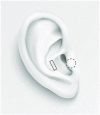Expiratory-gated Transcutaneous Auricular Vagus Nerve Stimulation (taVNS) does not Further Augment Heart Rate Variability During Slow Breathing at 0.1 Hz
- PMID: 36920567
- PMCID: PMC10412484
- DOI: 10.1007/s10484-023-09584-4
Expiratory-gated Transcutaneous Auricular Vagus Nerve Stimulation (taVNS) does not Further Augment Heart Rate Variability During Slow Breathing at 0.1 Hz
Abstract
As cardiac vagal control is a hallmark of good health and self-regulatory capacity, researchers are seeking ways to increase vagally mediated heart rate variability (vmHRV) in an accessible and non-invasive way. Findings with transcutaneous auricular vagus nerve stimulation (taVNS) have been disappointing in this respect, as its effects on vmHRV are inconsistent at best. It has been speculated that combining taVNS with other established ways to increase vmHRV may produce synergistic effects. To test this idea, the present study combined taVNS with slow breathing in a cross-over design. A total of 22 participants took part in two sessions of breathing at 6 breaths/min: once combined with taVNS, and once combined with sham stimulation. Electrical stimulation (100 Hz, 400 µs) was applied during expiration, either to the tragus and cavum conchae (taVNS) or to the earlobe (sham). ECG was recorded during baseline, 20-minutes of stimulation, and the recovery period. Frequentist and Bayesian analyses showed no effect of taVNS (in comparison to sham stimulation) on the root mean square of successive differences between normal heartbeats, mean inter-beat interval, or spectral power of heart rate variability at a breathing frequency of 0.1 Hz. These findings suggest that expiratory-gated taVNS combined with the stimulation parameters examined here does not produce acute effects on vmHRV during slow breathing.
Keywords: Breathing at 0.1 Hz; Heart rate variability (HRV); Slow breathing; Transcutaneous auricular vagus nerve stimulation (taVNS).
© 2023. The Author(s).
Conflict of interest statement
The authors declares that the authors have no conflict of interest.
Figures




Similar articles
-
Ear your heart: transcutaneous auricular vagus nerve stimulation on heart rate variability in healthy young participants.PeerJ. 2022 Nov 21;10:e14447. doi: 10.7717/peerj.14447. eCollection 2022. PeerJ. 2022. PMID: 36438582 Free PMC article.
-
Does transcutaneous auricular vagus nerve stimulation affect vagally mediated heart rate variability? A living and interactive Bayesian meta-analysis.Psychophysiology. 2021 Nov;58(11):e13933. doi: 10.1111/psyp.13933. Epub 2021 Sep 2. Psychophysiology. 2021. PMID: 34473846 Review.
-
Transcutaneous Auricular Vagus Nerve Stimulation Combined With Slow Breathing: Speculations on Potential Applications and Technical Considerations.Neuromodulation. 2022 Apr;25(3):380-394. doi: 10.1111/ner.13458. Epub 2021 Jun 23. Neuromodulation. 2022. PMID: 35396070 Review.
-
Neurophysiologic effects of transcutaneous auricular vagus nerve stimulation (taVNS) via electrical stimulation of the tragus: A concurrent taVNS/fMRI study and review.Brain Stimul. 2018 May-Jun;11(3):492-500. doi: 10.1016/j.brs.2017.12.009. Epub 2017 Dec 29. Brain Stimul. 2018. PMID: 29361441 Free PMC article. Clinical Trial.
-
The combined effect of transcutaneous electrical nerve stimulation and transcutaneous auricular vagus nerve stimulation on pressure and heat pain thresholds in pain-free subjects: a randomized cross-over trial.Trials. 2024 Jul 31;25(1):516. doi: 10.1186/s13063-024-08352-x. Trials. 2024. PMID: 39085951 Free PMC article.
References
-
- Borges U, Pfannenstiel M, Tsukahara J, Laborde S, Klatt S, Raab M. Transcutaneous vagus nerve stimulation via tragus or cymba conchae: Are its psychophysiological effects dependent on the stimulation area? International Journal of Psychophysiology. 2021;161:64–75. doi: 10.1016/j.ijpsycho.2021.01.003. - DOI - PubMed
-
- Burger, A. M., D’Agostini, M., Verkuil, B., Diest, I. V. (n.d.). Moving beyond belief: A narrative review of potential biomarkers for transcutaneous vagus nerve stimulation., & Psychophysiology, n/a(n/a), e13571. 10.1111/psyp.13571 - PubMed
-
- Farmer, A. D., Strzelczyk, A., Finisguerra, A., Gourine, A. V., Gharabaghi, A., Hasan, A., Burger, A. M., Jaramillo, A. M., Mertens, A., Majid, A., Verkuil, B., Badran, B. W., Ventura-Bort, C., Gaul, C., Beste, C., Warren, C. M., Quintana, D. S., Hämmerer, D., Freri, E., & Koenig, J. (2020). International Consensus Based Review and Recommendations for Minimum Reporting Standards in Research on Transcutaneous Vagus nerve stimulation (Version 2020). Frontiers in Human Neuroscience, 14. 10.3389/fnhum.2020.568051. - PMC - PubMed
Publication types
MeSH terms
LinkOut - more resources
Full Text Sources
Research Materials

